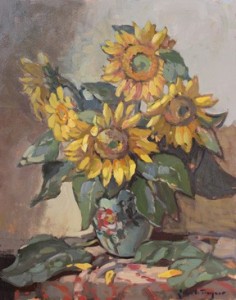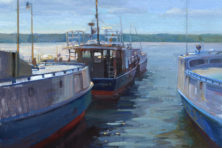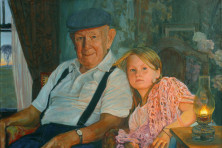Q&A – Questions & Artists: John C. Traynor
- Share
- Tweet
- Pin
- Share
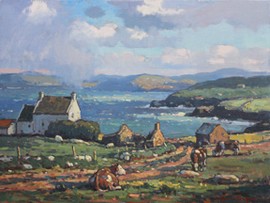
“Grazing by the Bay” by John C. Traynor.
My first experience seeing the work of artist John C. Traynor was about two years ago. Every winter I, along with several friends, spend one day a week painting in the studio of Jim Leatham in the Liberty Grove countryside.
Jim was talking about a great artist, John Traynor, whose work he had seen in an article in American Art Review. Jim had saved the magazine and I looked at the work and was captivated by Mr. Traynor’s use of color, composition, and value. Everything formed a cohesive pleasing painting. All the work was wonderfully done.
Over the past two years our painting group has discussed Mr. Traynor and his work many times and I was delighted when this interview was scheduled.
Done in early March, I think this interview will give the readers insight into Mr. Traynor’s view of what makes a great painting, and how he achieves this objective. I urge the readers to go to his website, johntraynor.com, to see examples of his work, still lifes, portraits and landscapes, all done in his subdued yet wonderfully pleasing style.
Traynor was born in Summit, New Jersey, and attended Catholic prep school. For as long as he remembers he has loved art. His art education began at Delbarton School in Morristown, New Jersey. His awards include the Salmagundi Club’s Medal of Merit and Honor. His painting style is reminiscent of some 19th century painters sometimes known as the Dutch Masters.
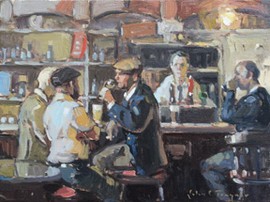
“Last Call” by John C. Traynor.
Randy Rasmussen (RR): Mr. Traynor when did you know you were going to be an artist?
John C. Traynor (JCT): It is hard to give a specific time but I wanted to do something I was good at. I was encouraged to continue my art by my family and teachers.
RR: You told me your family was very supportive.
JCT: I grew up in a large family and our parents always encouraged us to do what we were good at and enjoyed. My drawing and painting gave me a great deal of satisfaction and I was fortunate to have excellent instructors. Some of my instructors were full time artists and I thought they had a positive effect on my career choice.
RR: Who were some of the instructors that inspired you?
JCT: Caroll N. Jones and Frank Mason were two great instructors and both were commercially successful. I saw what they were doing and the success they were having and thought I could perhaps achieve the same thing.
RR: In your biography I found your studying sculpture with Brother Jerome in Italy interesting. How did this help develop your drawing and painting skills?
JCT: I did study sculpture in Italy for a year. I worked for him as a mold maker and learned the importance of thinking in a three-dimensional manner.
RR: In the opening paragraph of this interview I described how my friend found your work and enjoyed your paintings. Your style seems unique. How would you describe your work?
JCT: It is hard for me to label my work. Most people describe what I do as impressionistic. To me, every brushstroke is important. I also recognize the importance of the light falling on the subject.
Frank Mason, one of my primary instructors, talked about recognizing primary and secondary light. Initially, before I start a painting, I think of composition.
RR: Do you use an extensive palette?
JCT: Normally I use eight colors but when I teach I use the “Dumond Palette.” Some of the colors are separated into ten values, which helps the student understand how color relates to value in painting.
RR: What do you think is necessary to create a “good” painting?
JCT: I gravitate towards a painting that I never get tired of looking at. I think that I want to get a positive feeling from viewing the piece. Not all paintings achieve this but it is a goal.

“Lovers Lost in Paris” by John C. Traynor.
RR: Could you elaborate on words that are in your artist’s statement: “I love the randomness of nature.”
JCT: When painting outside every day is a new fresh experience. Things happen when you are working outdoors. There are endless smells, sights, sounds, sometimes wind, rain. Painting outside seems to make me work with a sharper vision and it is spontaneous.
RR: Why do you think art is still important?
JCT: I think people need art for inspiration. When the computer age came upon us it seemed a slowly painted piece of art increased in value, sort of a reaction against the frenetic pace of life. Many people that purchase my paintings hang them in their bedrooms. They look at the painting when they get up in the morning and feel good.
RR: Lastly, what is a John C. Traynor painting class about?
JCT: I have taught several classes over the years. I use the same formula that I went through learning how to draw and paint. It is the same formula that was used 100 years ago in the art colonies in the United States. Learning to see, to really see, takes time.
RR: Thank you.

